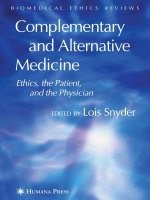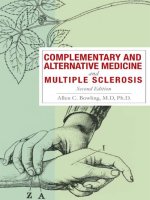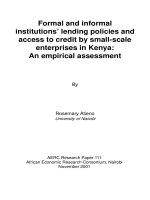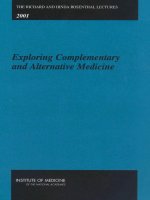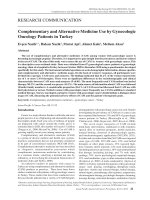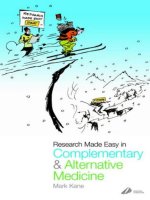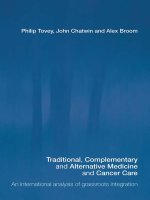Complementary and Alternative Medicine Use by Gynecologic Oncology Patients in Turkey ppt
Bạn đang xem bản rút gọn của tài liệu. Xem và tải ngay bản đầy đủ của tài liệu tại đây (466.58 KB, 5 trang )
Asian Pacic Journal of Cancer Prevention, Vol 13, 2012
21
DOI:
Complementary and Alternative Medicine Use by Gynecologic Oncology Patients in Turkey
Asian Pacic J Cancer Prev, 13, 21-25
Introduction
Cancer is a major disease burden worldwide and most
people perceive it as a frightening and untreatable disease
that implies death. Each year, tens of millions of people
are diagnosed with cancer around the world, and it is
estimated that in 2020, this number will reach 15 million
(Turgay et al., 2008; Ma and Yu, 2006). Use of CAM is
growing rapidly recent years among cancer patients.
Complementary and alternative medicine (CAM)
is a group of diverse medical and health care systems,
practices, and products that are not presently considered
to be part of conventional medicine (NCCAM 2011).
Complementary/alternative medicine has been described
as ‘diagnosis, treatmentand/or prevention which
complements mainstream medicine by contributing
to a common whole, satisfying a demand not met by
orthodoxy, or diversifying the conceptual frameworks of
medicine (Ades and Yarbro, 2000).
An unknown number of patients with cancer in
Turkey are using complementary and alternative medicine
(CAM) products or practices. There have been fewer
studies conducted with patients with gynecologic cancer
in Turkey. Those studies that have been conducted over
the past decade indicate that a variety of CAM therapies
1
Obstetric and Gynecologic Nursing, Department of Nursing, Adana Health School, Çukurova University,
2
Department of Obstetrics
and Gynecolog, Adana Numune Education Hospital, Adana, Turkey *For correspondence:
Abstract
The use of complementary and alternative medicines (CAM) among women with gynecologic cancer is
becoming increasingly popular. Therefore, it is important to gain insight into the prevalence and factors related
to the use of CAM. The aim of this study was to assess the use of CAM in women with gynecologic cancer. This
is a descriptive cross-sectional study. Data were obtained from 67 gynecological cancer patients at gynecologic
oncology clinic of a hospital in Turkey between October 2009 to December 2010 using a questionnaire developed
specically for this study. The instrument included questions on socio-demographic information, disease specics
and complementary and alternative medicine usage. On the basis of women’s responses, all participants were
divided into 2 groups: CAM users and nonusers. The ndings indicated that 61.2% of the women reported the
use of 1 or more CAM therapies. There were no signicant differences in the sociodemographic and clinical
characteristics between CAM users and nonusers (P <0.05). The most frequently used CAM method was herbal
therapy (90.2%) and the second was prayer (41.5%). The main sources of information about CAM were informal
(friends/ family members). A considerable proportion (56.1%) of CAM users had discussed their CAM use with
their physicians or nurses. Turkish women with gynecologic cancer frequently use CAM in addition to standard
medical therapy. Nurses/ oncologists caring for women with gynecologic cancer should initiate a dialogue about
usage of CAM, discussing the potential adverse effects of CAM and the patient’s therapeutic goals.
Keywords: Complementary and alternative medicines - gynecologic cancer - Turkey
RESEARCH COMMUNICATION
Complementary and Alternative Medicine Use by Gynecologic
Oncology Patients in Turkey
Evşen Nazik
1,*
, Hakan Nazik
2
, Murat Api
2
, Ahmet Kale
2
, Meltem Aksu
2
among patients with gynecologic cancer are used. Studies
investigating the prevalence of CAM use in cancer care
have reported that between 31% and 84% of gynecologic
cancer patients in Turkey (Mazicioğlu et al., 2006;
Yıldırım et al., 2006; Akyuz et al., 2007; Kav et al., 2008).
The seven major categories of CAM include
mind-body interventions, traditional or folk remedies,
special diets or nutrition programs, herbal medicine,
manual healing, chemical or pharmacologic agents,
and bioelectromagnetic applications (NCCAM, 2011).
Swisher and coworker found that 56 CAM users ingested
some type of CAM. Of CAM users, 23% used herbal
therapies or other plant extracts, 23% ingested high-
dose vitamins and/or minerals, 14% used medicinalteas
(including green teas and essiac), 18% used nontraditional
diet therapy (including juicing), and 7% took shark
cartilage, 79% used a psychological orspiritual therapy,
32% used meditation, yoga, or other relaxation techniques
(Swisher et al., 2002). A study conducted by Akyüz et al
(2007) in Turkey reported that patients with gynecologic
cancer used praying, worshipping, therapeutic touch,
high-dose vitamin and mineral therapy, herbal therapy,
animal organs, aromatherapy, diet regimens, acupuncture,
electromagnetic therapy, psychologic therapies, dreaming,
massage therapy, relaxation therapies, meditation (Akyüz
Evşen Nazik et al
Asian Pacic Journal of Cancer Prevention, Vol 13, 2012
22
et al, 2007). Many cancer patients use CAM to provide
treatment or cure, support treatment or cure, prevent
cancer and recurrence, as a substitute for conventional
treatment, and as a last resort in combination with
conventional medicine ( Yıldırım et al., 2006; Molassiotis
et al., 2006; Fasching et al., 2007).
CAM has been performed for centuries and is still
being accepted as an alternative therapy. However, usually
untrained people in this district practice CAM techniques.
Although gynecologists and oncologists are aware of the
widespread use of CAM, more information is needed
regarding beliefs and perceptions of CAM use. The
aims of this study were (a) to determine the prevalence of
complementary alternative medicine use among patients
with gynecologic cancer (b) to determine the types of
CAM used, (c) to describe sociodemographic and medical
factors associated with the use of CAM.
Materials and Methods
Setting and Sample
The cross-sectional survey study was performed on
67 patients with gynecologic cancers who were admitted
to the Gynecologic Oncology Department of Çukurova
Universitesi Balcalı Hospital between October 2009 to
December 2010. To be eligible, needed to be diagnosed
with a gynecologic cancer at least 1 month before the
interview. Patients assessed as in a preterminal state or
who were too ill to complete the interview were excluded.
Instruments
Data were collected using a semistructured
questionnaire administered to the gynecologic oncology
patients who were treated for cancer at Balcalı Hospital,
part of the largest university hospital in Mediterranean
region of Turkey, located in the city of Adana. Almost
all patients with cancer in this region, especially in Adana
and its surrounding areas, receive cancer treatment there.
The semistructured questionnaire form was developed
specifically for this study using questionnaires from
previously published studies as a guide. Swisher et al.,
2006, Akyuz et al., 2007; Gözüm et al., 2007; Supoken et
al., 2009; Yıldırım, 2010). Face validity for questionnaire
was determined by researchers. The questionnaire was
divided
into 3 sections, the rst of which was related to the
patients’ sociodemographic characteristics, such as age,
education level, marital status, occupation. Participants’
economic statuses were described as income < expenditure
or income = expenditure using self-report by the subject.
The second section of the questionnaire was related to
diseaserelated characteristics, such as type of cancer,
treatment modality, time of diagnosis, status of recurrence
of cancer.
The third section of the questionnaire asked patients
whether or not they used any form of CAM . The
researcher described CAM to the patients. Then, patients
were asked whether they had ever used or were using
any of the following 12 CAM therapies: acupuncture,
aromatherapy, herbal medicine, nutritional supplements,
exercise, relaxation therapies (including relaxation,
0
25.0
50.0
75.0
100.0
Newly diagnosed without treatment
Newly diagnosed with treatment
Persistence or recurrence
Remission
None
Chemotherapy
Radiotherapy
Concurrent chemoradiation
10.3
0
12.8
30.0
25.0
20.3
10.1
6.3
51.7
75.0
51.1
30.0
31.3
54.2
46.8
56.3
27.6
25.0
33.1
30.0
31.3
23.7
38.0
31.3
hypnosis, meditation, yoga, and biofeedback), imagery,
massage therapy, prayer, homoeopathy, energy healing
(including Reiki) or other CAMs mentioned by the
participants. Classication of the CAM categories was
based on the CAM classication of the National Center
for Complementary and Alternative Medicine. After
the participants were asked for the type of CAM they
use, other questions such as reason for use, information
source toward CAM modalities, anticipated benets and
adverse effects, and communication about CAM use
with physicians or nurses were also asked. Open-ended
questions were used, and answers were categorized
Procedures
Because the clinic chief’s approval is enough to carry
out the descriptive studies, the study was approved by
the chief of Obstetric and Gynecologic Clinic of Balcalı
Hospital, Çukurova University. In order to obtain patient’s
verbal consent, all participants were informed of the
purpose of the study, ensured that the collected information
would be used solely for scientic purposes, would be
kept condential and not shared by others except the
researchers. All participants were also assured that their
explanations with regard to CAM use would not affect
their future care and would not be used for other purposes
than scientic researches.
A face to-face interview method to administer the
questionnaires by the researcher was used. The interviews,
which lasted for about 15 minutes, were conducted by
the investigator in the patient’s room. Disease-related
characteristics were obtained from patient les.
Data Analyses
The statistical analyses were performed using SPSS
for Windows version 13.0. Descriptive statistics were
calculated for all variables. The study participants were
categorized as either CAM users or nonusers. Comparisons
between the groups were assessed using the Chi-square
0
25.0
50.0
75.0
100.0
Newly diagnosed without treatment
Newly diagnosed with treatment
Persistence or recurrence
Remission
None
Chemotherapy
Radiotherapy
Concurrent chemoradiation
10.3
0
12.8
30.0
25.0
20.3
10.1
6.3
51.7
75.0
51.1
30.0
31.3
54.2
46.8
56.3
27.6
25.0
33.1
30.0
31.3
23.7
38.0
31.3
Table 1. Sociodemographic Characteristics of Users
and Nonusers of Complementary and Alternative
Medicine Therapy
Characteristics Users (n=41) Nonusers (n=26) P
Educational status
Read and write 20 48.8 11 42.4
Primary school 10 24.4 9 34.6 0. 837
High school 6 14.6 3 1.5
University 5 12.2 3 11.5
Marital status
Married 24 58.5 17 65.4
Divorced 3 7.3 3 11.5 0.579
Widowed 14 34.2 6 23.1
Occupation
Housewife 39 95.1 23 88.5 0.312
Worker 2 4.9 3 11.5
Economic status
Income<expenditure
22 53.7 17 65.4 0.343
Income≥expenditure
19 46.3 9 34.6
Place of residence
City 19 46.3 10 38.5
Asian Pacic Journal of Cancer Prevention, Vol 13, 2012
23
DOI:
Complementary and Alternative Medicine Use by Gynecologic Oncology Patients in Turkey
Table 2. Disease-Related Characteristics of Users and
Nonusers of Complementary and Alternative Medicine
(CAM) Therapy
Characteristics Users (n=41) Nonusers (n=26) P
Type of cancer
Ovarian cancer 31 75.6 23 88.5
Endometrial cancer 7 17.1 3 11.5 0.465
Cervical cancer 2 4.9 - -
Tubal cancer 1 2.4 - -
Treatment modality
Surgery 7 17.0 1 3.8
Chemotherapy 22 53.7 20 76.9 0.114
Surgery +Chemo 12 29.3 5 19.3
Time of diagnosis
1-6 month 17 41.5 7 26.9 0.471
7-12 month 7 17.0 5 19.3
1 year and longer 17 41.5 14 53.8
Status of recurrence of cancer
Yes 14 34.1 13 50.0 0.197
No 27 65.9 13 50.0
Table 3. Type and Prevalence of CAM Therapies Used
by the Patients. CAM Indicates Complementary and
Alternative Medicine
CCAM method* n= 41 N %
Herbal therapy 37 90.2
Massage therapy 2 4.9
Relaxation therapies 1 2.4
Diet regimens 4 9.8
( high protein content fruit and vegetable-based)
Praying 17 41.5
Acupuncture 1 2.4
Psychologic therapies 4 9.8
Aromatherapy 1 2.4
* ‘Respondents may report more than one answer
test and Student t test. P<0.05 was accepted as the level
of prespecied statistical signicance.
Results
The sociodemographic characteristics of the patients
with gynecologic cancer are summarized in Table1. The
average age of the patients was 58.23 years (SD = 12.3).
28.4 % were primary school graduates, 61.2 % of the
patients were married, and 92.5% were housewives.
The medical characteristics of the patients with
gynecologic cancer are summarized in Table 2. The
Table 4. Distributions of Names and Primary Reasons for Use of Herbal Supplements Used Among the Herbal
Supplement Users
English Name Latin Name Turkish Name N % Primary Reason for CAM Use
Sage tea Salvia ofcinalis Ada çayı 2 5.4 Treat cancer (n = 1)
Achieve physical and emotional well-being (n = 1)
Liquirrhitae radix Glycyrrhize glabra Meyan kökü 4 10.8 Treat cancer (n = 1)
Achieve physical and emotional well-being (n = 1)
Relieve cancer
treatment-related symptoms (n=2)
Boost immune system (n = 1)
Stinging nettle Urtica dioica Isırgan 14 37.8 Treat cancer (n = 10)
Achieve physical and emotional well-being (n = 1)
Relieve cancer
treatment-related symptoms (n=2)
Boost immune system (n = 1)
Green tea Camellia sinensis Yeşil çay 4 10.8 Treat cancer (n = 1)
Achieve physical and emotional well-being (n = 2)
Relieve cancer
treatment-related symptoms (n=1)
Black mulberry Morus nigra Urmu dutu 2 5.4 Boost immune system (n = 2)
Juniper Juniperus Nanawilid Ardıç tohumu 3 4.5 Achieve physical and emotional well-being (n = 3)
Parsley Petroselinum crispum Maydanoz 2 5.4 Treat cancer (n = 1)
Relieve cancer
treatment-related symptoms (n=1)
Camomile Anthemis nobilis Papatya 2 5.4 Treat cancer (n = 1)
Relieve cancer
treatment-related symptoms (n=1)
Ginger Rhizome zingiberis Zencel 3 7.1 Treat cancer (n = 1)
Boost immune system (n = 2)
Turmeric Curcuma longa Zerdeçal 1 2.7 Treat cancer (n = 1)
most frequent diagnosis included ovarian cancer (80.6%).
More than half (62.7%) of the patients were currently
receiving chemotherapy. There were no significant
differences between users and nonusers of CAM regarding
educational level (P = .837), marital status (P = .579) and
occupation (P = .312). There were also no differences
between the groups with respect to type of cancer (P =
.465), treatment modality (P = .114), Time of diagnosis
(P = .471), Status of recurrence of cancer (P =0.197)
(Tables 1 and 2).
Of the 41 (61.2%) women used multiple types of
CAM. Most of the CAM users were using herbs. Of the
41 CAM users, 37 (90.2%) used herbal therapies, 17
(41.5%) used praying, 4 (9.8%) ingested diet regimens.
Four women (9.8% of users) used a psychological therapy,
two women (4.8%) used massage therapies, one women
(2.4%) used relaxation therapies (Table 3)
Evşen Nazik et al
Asian Pacic Journal of Cancer Prevention, Vol 13, 2012
24
Among the herbs used, 37.8 % used stinging netle,
10.8% used green tea, 10.8% used Liquirrhitae radix.
The main reasons for using CAM were to treat cancer
(48.8%), to achieve physical and emotional well-being
(24.4%), to relieve cancer treatment-related symptoms
(9.0%), to boost immune system (7.5%) (Table 4). 90.2 %
of patients reported that they observed benets after CAM.
The most common actual benet these women perceived
was an improvement in psychosocial well-being, including
increased hope or optimism. However, only one patient
(2.4%) reported no benets from using CAM. One patient
(2.4 %) also reported side effects from using CAM.
Participants were asked where they had gotten
information about CAM. These data are detailed in Table
5. 31.7 % of women received information about CAM
from their family members. Only one patient received
information about CAM from a physician, nurse, or
practitioner of CAM. 56.1% of patients stated that they
were informed their nurse/physician about CAM.
Discussion
This study documenting the use of CAM in a group
of patients with gynecological cancer. The prevalence
of CAM therapy use among patients with gynecological
cancer in the current study is higher than that reported by
Yıldırım et al, Fasching et al, Molassıotis et al, (58%,
44%, and 40%, respectively), lower than that reported by
Richardson et al., Boon et al. (89%, 67%, respectively),
but comparable to the prevalence reported by Von
Gruenigen et al (60%). The generally high and possibly
growing prevalence of CAM use by patients with cancer
renders this topic an important candidate for rigorous
investigation.
The literature suggests that there may be a typical
prole of CAM user, with younger age, higher educational
level, and higher economic status commonly reported
(Richardson et al, 2000; Von Gruenıgen et al, 2001;
Henderson and Donatelle 2004; Gözüm et al, 2007).
However, in the present study, this was not conrmed
as our sample of CAM users did not differ signicantly
from the group of nonusers. This suggests that a typical
prole of CAM user may not exist, as many patients
with cancer will do everything to have a better chance
with their illness, irrespective of their sociodemographic
characteristics.
The CAM used by patients was mostly herbal therapy.
This nding was consistent with other studies conducted
0
25.0
50.0
75.0
100.0
Newly diagnosed without treatment
Newly diagnosed with treatment
Persistence or recurrence
Remission
None
Chemotherapy
Radiotherapy
Concurrent chemoradiation
10.3
0
12.8
30.0
25.0
20.3
10.1
6.3
51.7
75.0
51.1
30.0
31.3
54.2
46.8
56.3
27.6
25.0
33.1
30.0
31.3
23.7
38.0
31.3
0
25.0
50.0
75.0
100.0
Newly diagnosed without treatment
Newly diagnosed with treatment
Persistence or recurrence
Remission
None
Chemotherapy
Radiotherapy
Concurrent chemoradiation
10.3
0
12.8
30.0
25.0
20.3
10.1
6.3
51.7
75.0
51.1
30.0
31.3
54.2
46.8
56.3
27.6
25.0
33.1
30.0
31.3
23.7
38.0
31.3
Table 5. Information Sources of CAM Users About
CAM Therapies
N %
Information Sources of CAM Users About CAM Therapies
Herself 7 17.1
Family members 13 31.7
Media or Internet 6 14.6
Friends 14 34.1
Healthcare providers 1 2.4
Discussed with nurse/physician
Yes 23 56.1
No 18 43.9
in Turkey and other countries. Previous Turkish studies
had indicated that herbal therapies among adult patients
with cancer were the most used alternative methods of
treatment (Ceylan et al., 2002; Gözüm et al., 2003;
Akyüz et al., 2007; Kav et al., 2008, Gözüm et al., 2007;
Yıldırım, 2010). This result was also consistent with
other studies related to this topic, in that herbal therapies
among patients with cancer were one of the most used
alternative methods of treatment noted (Molassiotis et al,
2006; Matthews et al, 2009).
Our population had a high usage of spiritually therapy
(prayer) similar to that reported by Swısher et al. (2002).
That the second most common CAM method is prayer
is not surprising in Turkey, where an estimated 99% of
people are Muslims, who pray and believe that whatever
happens comes from God. Spiritual strategies seem to
entail minimal risks of side effects or interactions with
conventional treatment and, on the other hand, may even
make patients feel better. Therefore, nurses/ physicians
should avoid categorical rejection of this form of CAM
treatment.
Stinging nettle was the most frequently reported CAM
in this study. Interest in herbal therapies has been growing
rapidly in Turkey. Commonly used herbs used in Turkey
include stinging nettle (U. dioica) for the treatment of
illnesses (Gözum and Unsal 2004). Herbal combinations
(mainly U. dioica) are also the most frequently used
remedy among adult patients with cancer (Ceylan et al,
2002). The traditional attitudes and beliefs of the people,
the easy access to this plant, and the low cost help to
explain a higher rate of selecting stinging nettle in our
study and other Turkish studies in this area. However,
some CAM, especially certain herbs, can be potentially
dangerous for patients or might be dangerous when
combined with conventional cancer treatment that patients
are already receiving. Herbs can cause direct and indirect
health risks and benets.
The main reasons reported in the present study for
using CAM are similar to those reported elsewhere
(Swisher et al, 2002; Molassiotis et al, 2006; Akyüz et
al, 2007; Yıldırım et al, 2010). The idea of using CAM
to treating cancer was reported signicantly more often
by patients. The data suggest that patients may want to
maintain optimism and hope when faced with cancer, and
this may be one of the key motivators for patients to use
CAM ( Ritvo et al., 1999).
The most frequent sources of information about CAM
(friends and family members) are similar to those reported
by Shen et al. (2002) and Swısher et al. (2002). Only about
2.4% of patients received CAM information from their
physicians and/or nurses. It is probable that patients do
not reveal CAM use to conventional health professionals
because of fear of negative feedback. These ndings also
indicate that patients rely on informal and uncontrolled
information and personal testimonials. The quality of this
information may be very low. However, good-quality
information sources are available to the clinician (Kiefer et
al, 2001). Good communication skills and open discussion
about CAM issues with the patients is the key to protecting
them from inappropriate and unhelpful use of CAM but
also to assist them to reach the most appropriate decision
Asian Pacic Journal of Cancer Prevention, Vol 13, 2012
25
DOI:
Complementary and Alternative Medicine Use by Gynecologic Oncology Patients in Turkey
for them about CAM.
At the current study, a signicant number of patients
with gynecologic cancers prefer CAM techniques as an
additional therapy to modern cancer therapy. Most women
with gynecologic cancer commonly used CAM therapy
among them is herbal medicine. It was determined that
patients with cancer usually received information about
CAM from not so scientically reliable sources such as
relatives, friends and the media. Healthcare providers
should routinely ask their patients about CAM use and
discuss the positive and negative results of CAM use with
them. Also, because of the high prevalence of the use of
CAM therapies among women with cancer, healthcare
providers dealing with cancer treatment should increase
their knowledge about these therapies.
References
Ades T, Yarbro HC (2000). Alternative and complementary
therapies in cancer management. In: Yarbro HC, Frogge
MH, Goodman M, editors. Cancer Nursing Principles and
Practice, 5, 617-28.
Akyuz A, Dede M, Çetintürk A, et al (2007). Self-Application
of Complementary and Alternative Medicine by Patients
with Gynecologic Cancer. Gynecol Obstet Invest, 64, 75-81.
Boon H, Stewart M, Kennard MA, et al (2000). Use of
complementary/ alternative medicine by breast cancer
survivors in Ontario. Prevalence Perceptions, J Clin Onc,
18, 2515-21,
Ceylan S, Hamzaoglu O, Komurcu S, Betan C, Yalcin A.(2002).
Survey of the use of complementary and alternative medicine
among Turkish cancer patients. Complement Ther Med,
10, 94-9.
Fasching PA, Thiel F, Nicolaisen Murmann K, et al (2007).
Association of complementary methods with quality of life
and life satisfaction in patients with gynecologic and breast
malignancies. Support Care Cancer, 15, 1277-84.
Gözüm S, Tezel A, Koc M (2003). Complementary alternative
treatments used by patients with cancer in eastern Turkey.
Cancer Nurs, 26, 230-6.
Gözum S, Unsal A (2004). Use of herbal therapies by older,
community dwelling women. J Adv Nurs, 46, 171-8.
Gözüm S, Arikan D, Büyükavci M (2007). Complementary
and alternative medicine use in pediatric oncology patients
in Eastern Turkey. Cancer Nursing, 30, 38-44.
Henderson JW, Donatelle RJ (2004). Complementary and
alternative medicine use by women after completion of
allopathic treatment for breast cancer. Altern Ther Health
Med, 10, 52-7.
Kav S, Pinar G, Gullu F, et al (2008). Use of complementary
and alternative medicine in patients with gynecologic
cancer: is this usage more prevalent? J Altern Complement
Med, 14, 347-9.
Kiefer D, Shah S, Gardiner P, Wechkin H (2001). Finding
information on herbal therapy: a guide to useful sources for
clinicians. Altern Ther Health Med, 7, 74–8.
Ma X, Yu H (2006). Global burden of cancer. The Yale J of
Biology and Medicine, 79, 85-94.
Matthews AK, Sellergren SA, Huo D, List M, Fleming G (2007).
Complementary and alternative medicine use among breast
cancer survivors. J Altern Complement Med, 13, 555-62.
Mazicioglu MM, Serin MS, Sahan H (2006). Attitude of patients
with gynaecologic malignancies in selecting alternative and
complementary therapies. MEJFM, 14, 12-5.
Molassiotis A, Scott JA, Kearney N, et al (2006). Complementary
and alternative medicine use in breast cancer patients in
Europe. Support Care Cancer, 14, 260-267.
National Center for Complementary and Alternative Medicine
(NCCAM) (2011) What is CAM?. Available at: http://www.
nccam.nih.gov (accessed 1 February 2011).
Richardson MA, Sanders T, Palmer JL, Singletary SE (2000).
Complementary/alternative medicine use in a comprehensive
cancer center and the implications for oncology. J Clin Onc,
18, 2505-14.
Ritvo P, Irvine J, Katz J, et al (1999). The patient’s motivation
in seeking complementary therapies. Patient Educ Couns,
38, 161-5.
Shen J, Andersen R, Albert PS, et al (2002). Use of complementary/
alternative therapies by women with advanced-stage breast
cancer. BMC Complement Altern Med, 13, 2-8.
Supoken A, Chaisrisawatsuk T, Chumworathayi B (2009).
Proportion of gynecologic cancer patients using
complementary and alternative medicine. Asian Pac J
Cancer Prev, 10, 779-82.
Swisher EM, Cohn DE, Goff BA, et al (2002). Use of
complementary and alternative medicine among women with
gynecologic cancers. Gynecol Oncol, 84, 363-7.
Turgay AS, Khorshid L, Eser I (2008). Effect of the first
chemotherapy course on the quality of life of cancer patients
in Turkey. Cancer Nursing, 31, 19-23.
Von Gruenıgen VE, Whıte LJ, Kırven MS, et al (2001). A
comparison of complementary and alternative medicine
use by gynecology and gynecologic oncology patients, Int
J Gynecol Cancer, 11, 205-9.
Yıldırım Y, Tinar S, Yorgun S, et al (2006). The use of
complementary and alternative medicine (CAM) therapies
by Turkish women with gynecological cancer. Eur J
Gynaecol Oncol, 27, 81-5.
Yıldırım Y (2010) Patterns of the Use of complementary and
alternative medicine in women with metastatic cancer .
Cancer Nursing, 33, 194-200.
